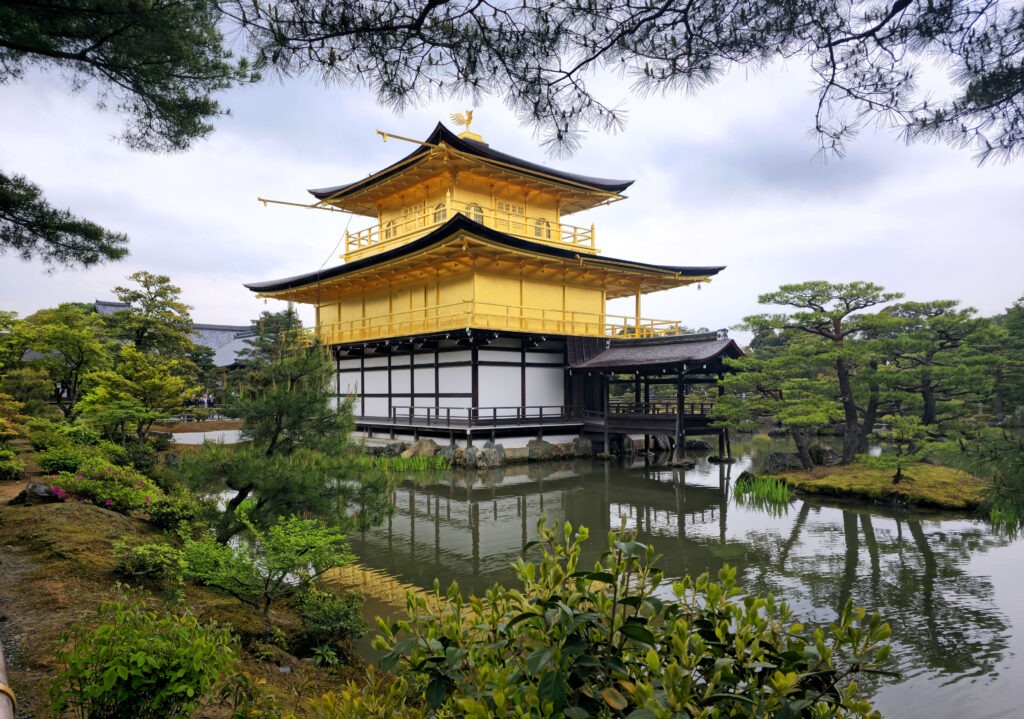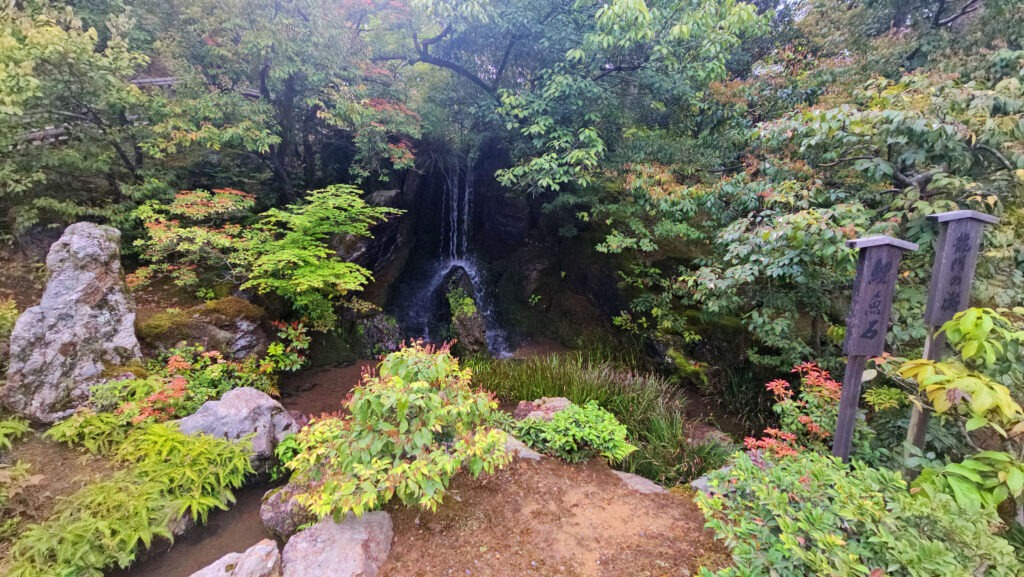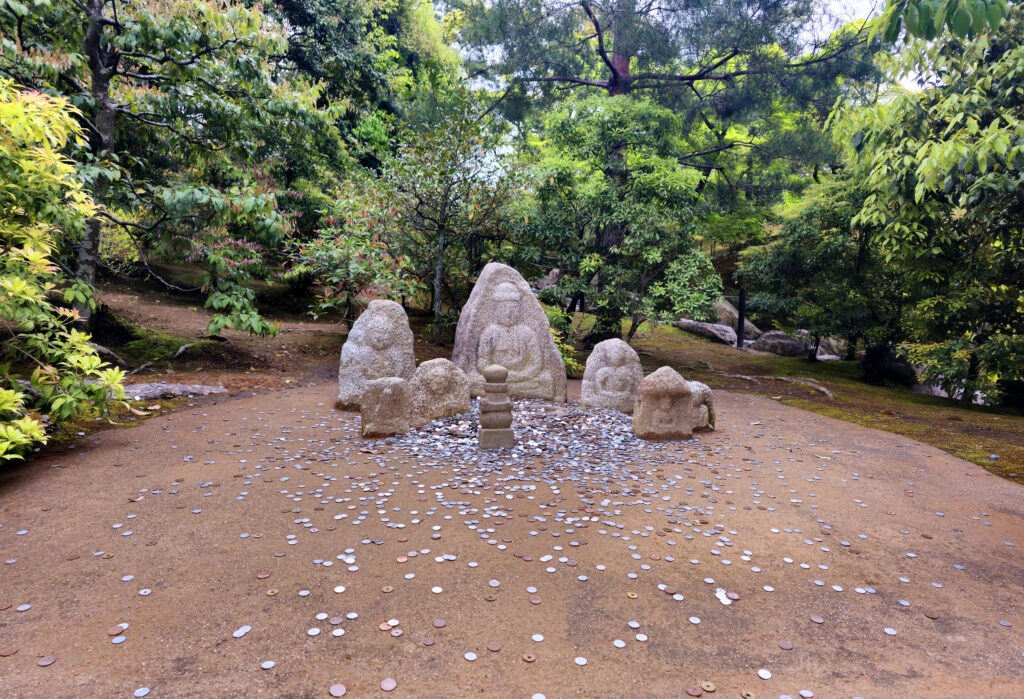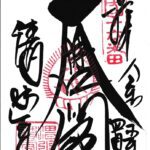Would you like to visit Kinkakuji Temple, one of Japan’s most beautiful and iconic sites? Are you curious about the temple’s history and the symbolism behind its shimmering appearance in the sunlight? Our article covers all you need to know about this magnificent place—from its origins and evolution to the best times for a visit. Rest assured, by the end, you’ll be tempted to pack your bags and journey to Kyoto for an up-close experience.

History of Kyoto’s Kinkaku-ji Temple
The official name of the temple is Rokuon-ji, which translates to “Deer Garden Temple,” but it is more commonly known as Kinkakuji due to the golden hue of its main structure, the Golden Pavilion.
Constructed in 1397, Kinkakuji Temple initially served as a retreat villa for Ashikaga Yoshimitsu, the influential shogun of the Muromachi era (1336-1573). Yoshimitsu, a prominent and ambitious figure, sought to showcase his opulence and stature through his dwelling. Hence, he adorned the exterior of the building with delicate gold leaf, giving it a striking and dazzling appearance.
Surrounded by a serene zen garden, the temple featured a pond that reflected the resplendent image of the pavilion. The shogun often reveled in the tranquility and beauty of his villa, hosting esteemed guests and extravagant gatherings.
Following Yoshimitsu’s passing in 1408, his final wishes led to the transformation of the villa into a Zen Buddhist temple affiliated with the Rinzai school. This transformation gave rise to the Kinkakuji Temple, establishing it as a revered and sacred site cherished by many devout followers.
The temple served as a repository for Buddhist relics and art pieces, drawing visits from monks, aristocrats, and pilgrims. Throughout Japanese history, the temple endured turbulent periods, including the Ōnin War, a destructive civil conflict that ravaged Kyoto from 1467 to 1477. Despite the city facing fires and pillaging, the temple miraculously withstood the chaos and remained intact.

However, the temple faced a dramatic turn of events in 1950, when a mentally troubled young monk set fire to the structure, resulting in its complete destruction. The monk was deeply disturbed by his actions and subsequently took his own life.
The devastating fire at Kinkakuji Temple stunned both the nation and the world, becoming immortalized in the novel “The Golden Pavilion” by Japanese author Yukio Mishima. Initially, many believed that the temple would never be reconstructed. However, owing to the determination and contributions of the public, sufficient funds were raised to initiate its restoration.
The restored Kinkakuji temple
The reconstructed Kinkakuji temple was completed in 1955, meticulously adhering to the original 14th-century design. However, the present-day Kinkakuji is a faithful reproduction of its predecessor, but with a greater amount of gold leaf adorning its exterior.
Comprising three stories, each level boasts distinct architectural styles. The first floor, known as Hōsui-in, reflects the shinden style reminiscent of the aristocratic residences of the Heian period (794-1185). The second floor, named Chōondō, embodies the buke-zukuri style, reminiscent of samurai dwellings during the Kamakura period (1185-1333). Lastly, the third floor, called Kukkyo-chō, embraces the karayo style inspired by Zen temples.
The top two stories are lavishly covered in pure gold leaf, which was refreshed in 1987 to enhance its brilliance and endurance. Notably, the temple also features a golden phoenix statue atop its roof, symbolizing rebirth and eternity.

Visitors are unable to enter the pavilion’s interior, but the presence of the Buddha and the goddess Kannon inside can still be admired from the exterior.
Kinkakuji Temple stands as a representation of the harmony among heaven, earth, and water. It embodies the three truths of Buddhism: illusory truth, relative truth, and absolute truth. Moreover, it serves as a sacred site dedicated to Kannon, the goddess of mercy, believed to offer protection to the temple.
Inspiring landscapes
Today, Kinkakuji temple stands as one of Japan’s most visited and photographed destinations. Recognised as a UNESCO World Heritage Site in 1994, the temple continues to serve as a revered location for religious ceremonies and the conservation of historical artifacts. However, beyond its religious significance, the temple is also celebrated for its aesthetic allure, inviting visitors to appreciate the ever-changing beauty and harmony of nature throughout the seasons.

In spring, you can witness the striking contrast between the gold of the temple and the pink of the cherry blossoms. Enjoy the lush green trees and the clear blue sky in summer. In autumn, appreciate the vibrant red and orange of the falling leaves. And in winter, marvel at the serene white snow covering the temple.
The Golden Pavilion is majestically reflected in the Kyoko-chi Pond, which means “Mirror of Water”. This pond is surrounded by the beautiful Japanese garden, Rokuon-ji, a unique historical and landscape monument. It is designed to offer different views of the Golden Pavilion as you walk through it.
The carefully pruned trees and thoughtful details in every corner of the garden highlight the natural beauty and perfection found in simplicity. The garden also features rocks, bridges, waterfalls, and colorful tents symbolizing Buddhist cosmology.
Additionally, you can see the Ryumon-taki waterfall, which is only 2.3 meters high. At its top is a rock known as rigyoseki, or “carp-rock”, associated with a Chinese legend about a carp that turned into a dragon by climbing this waterfall.

Another must-see is the Anmintaku Pond, renowned for never drying up. In the pond, there is a small island with a five-story stone pagoda. Visitors also toss coins at the stone statues to attract good luck.

Opening Hours and Best Time to Visit the Kinkakuji Temple
Planning your visit to Kinkakuji around its opening hours and the season is crucial. The temple is open from 9am to 5pm, so arriving early is recommended to avoid crowds and fully appreciate the tranquility of the site.
The ideal times to visit are in spring, when the cherry blossoms are in full bloom, or in autumn, when the leaves turn beautiful shades of red and gold.
Admission is 500 yen for adults and 300 yen for children.

How to get to Kinkakuji Temple
There are several public transportation options to reach Kinkakuji Temple.
One option is to take bus number 101 or 205 from Kyoto Station to the Kinkakuji-michi stop, which is about a 5-minute walk from the temple.
Alternatively, you can take the Karasuma Line subway to Kitaoji Station and then transfer to bus number 101, 102, 204, or 205 to the Kinkakuji-michi stop. The total journey by subway and bus takes about 40 minutes from Kyoto Station.
You can also take a taxi from Kyoto Station to the temple, but it is more expensive and the travel time depends on traffic conditions.
Where to sleep in Kioto
Consider staying in a machiya, a traditional Japanese house, especially if you’re traveling with your family.
🏠 Machiya:
If you prefer staying near Kyoto Station, this hotel is only a 3-minute walk away:
🏩 Near Kyoto Station:
Our preferred option is to stay in the Gion district. Hotel ZIZI Kyoto Gion offers spacious rooms with balconies at very affordable prices:



